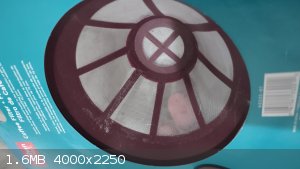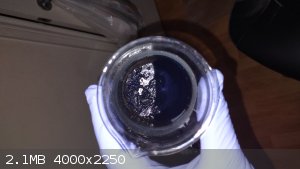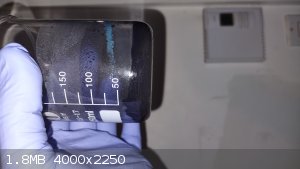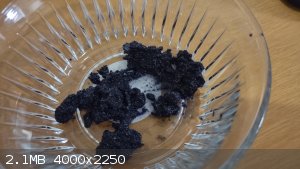| Pages:
1
2
3
4 |
Laboratory of Liptakov
International Hazard
    
Posts: 1396
Registered: 2-9-2014
Location: Technion Haifa
Member Is Offline
Mood: old jew
|
|
Not total wet. On first look the agglomerates seems dry. Same a like salt or sucrose in kitchen. Or ammonium nitrate. They are also not dry never.
There is also content of water in crystals. In CHP is moisture of ammonia water, which causes easy DDT and his typical smell. For example, old CHP or
too much dry CHP can be activated. A few drop of ammonia water, create dense porridge and dry again shortly. His DDT properties will renewed.
Development of primarily - secondary substances CHP (2015) Lithex (2022) Brightelite (2023) Nitrocelite and KC primer (2024)
|
|
|
Brightthermite
Hazard to Others
  
Posts: 133
Registered: 26-6-2019
Member Is Offline
|
|
Awh I understand now what you mean. My "air dried" CHP always smells strongly of ammonia and if touched with you bare skin feels how I could only
describe as greasy (still having ammonia).
|
|
|
Gargamel
Hazard to Others
  
Posts: 166
Registered: 9-3-2013
Member Is Offline
Mood: No Mood
|
|
Had some nice firecrackers with 5mm papertubes.
Test in 5mm inner / 6mm outer diameter copper pipe failed
PETN @ 500psi
CHP @ 200psi
CHP @ 80psi
CHP @ 20psi around the fuse
The PETN left a white disk on the witness plate, some blue streaks indicate the the CHP did no go DDT...
Maybe 0,5mm wall thickness was too optimistic 
[Edited on 18-7-2021 by Gargamel]
|
|
|
Brightthermite
Hazard to Others
  
Posts: 133
Registered: 26-6-2019
Member Is Offline
|
|
Quote: Originally posted by Gargamel  | Had some nice firecrackers with 5mm papertubes.
Test in 5mm inner / 6mm outer diameter copper pipe failed
PETN @ 500psi
CHP @ 200psi
CHP @ 80psi
CHP @ 20psi around the fuse
The PETN left a white disk on the witness plate, some blue streaks indicate the the CHP did no go DDT...
Maybe 0,5mm wall thickness was too optimistic 
[Edited on 18-7-2021 by Gargamel] |
Ill note that I do not get very fancy with pressing my CHP. I load the .7 grams in maybe .15 grams at a time and just press it flat by hand. The CHP
grain size is pretty fine tho, like fine sand. I believe some of the voids are what help it DDT.
|
|
|
MineMan
International Hazard
    
Posts: 1004
Registered: 29-3-2015
Member Is Offline
Mood: No Mood
|
|
You need 1-2mm grains. Like bright said, needs to be like sand. That test is not too optimistic, I think LL showed it works in a thin aluminum tube
too. I bet carbon fiber arrow works great as well. To be blunt, CHP is pretty fool proof, if it’s not working it’s not the finesse, rather a major
detail. Only one I can think of is grain size.
|
|
|
Gargamel
Hazard to Others
  
Posts: 166
Registered: 9-3-2013
Member Is Offline
Mood: No Mood
|
|
Mine are definitely smaller, more like 600µ or so.
Fine sand...
May I ask what mesh size sieves you guys used?
Also I found my crystals weren't much bigger before I granulated. Although I gave them a slow cooldown, ample time to grow...
Also I found that the crystals aren't very tough, or at least it felt like it... I felt that there was nothing more to compress at values much lower
than LL gave in his videos. The voids between the granules seem to collapse rather quickly...
edit:
Recrystalisation from concentrated spirit of ammonia seems to be the right way...?
[Edited on 20-7-2021 by Gargamel]
|
|
|
Laboratory of Liptakov
International Hazard
    
Posts: 1396
Registered: 2-9-2014
Location: Technion Haifa
Member Is Offline
Mood: old jew
|
|
Again, much more important than grain size is the right way to prepare CHP. 4.4g TACP + 0.3g hexamine + 0.3g NH4ClO4. Moisten the ingredients with
ammonia water to the consistency of the slurry. Rub to the consistency of mashed potatoes, without visible grains. Push the semi-dry slurry through a
2x2 mm sieve. Dry on a surface of 50 C for 5 minutes. Enclose in an airtight container. If the CHP is properly prepared, it also works in a 6/8 mm
aluminum cavity. And only 2 densities are enough. 0.3g on 30 Kg. (50Kg) And 0.7g compressed to, for example, 5 Kg. (3 - 10 Kg). If you use PETN, you
can simply mixing with CHP 1:1. And pressed into cavity for example on 10 Kg. However beware. CHP is alkaline compound. Can degradate PETN after a one
week partially. Same conditions are for ETN. 1:1, heterogenous mixture.
Development of primarily - secondary substances CHP (2015) Lithex (2022) Brightelite (2023) Nitrocelite and KC primer (2024)
|
|
|
Gargamel
Hazard to Others
  
Posts: 166
Registered: 9-3-2013
Member Is Offline
Mood: No Mood
|
|
OK, next time.
So - the CuO method is now "officially" discouraged?
|
|
|
MineMan
International Hazard
    
Posts: 1004
Registered: 29-3-2015
Member Is Offline
Mood: No Mood
|
|
It does not make sense to me. Maybe it works with stronger ammonia, but…. I find it is impossible to separate out. tACP is really soluable, so if
you let it sit too long in the mother liquid or trying to extract it, it’s a pain. You will end up with jars of blue liquid that you realize is too
much work to tackle and all your AP is gone! Where did it go, it went into these blue jars. Maybe LL knows a way…. But
|
|
|
Brightthermite
Hazard to Others
  
Posts: 133
Registered: 26-6-2019
Member Is Offline
|
|
Yeah the CuO method has never worked very well for me
|
|
|
Laboratory of Liptakov
International Hazard
    
Posts: 1396
Registered: 2-9-2014
Location: Technion Haifa
Member Is Offline
Mood: old jew
|
|
Ammonia water must be (for TACP separation) maximally concentrated and cooled to zero Celsius, or -10 C.
25% concentration of ammonia water (or higher) is the basis of success.
Development of primarily - secondary substances CHP (2015) Lithex (2022) Brightelite (2023) Nitrocelite and KC primer (2024)
|
|
|
MineMan
International Hazard
    
Posts: 1004
Registered: 29-3-2015
Member Is Offline
Mood: No Mood
|
|
Quote: Originally posted by Laboratory of Liptakov  | Ammonia water must be (for TACP separation) maximally concentrated and cooled to zero Celsius, or -10 C.
25% concentration of ammonia water (or higher) is the basis of success. |
I meant separating TACP from CuO
|
|
|
Laboratory of Liptakov
International Hazard
    
Posts: 1396
Registered: 2-9-2014
Location: Technion Haifa
Member Is Offline
Mood: old jew
|
|
Oh yes sorry for my English. For example, a small amount of CuO in TACP 1-5% does not have a negative effect on energy properties. However, it is
always better to use metallic copper, sheets, wires for the reaction. With an excess for the reaction of, for example, 100% relative to the
stoichiometric weight. These can be easily removed after the reaction.
Development of primarily - secondary substances CHP (2015) Lithex (2022) Brightelite (2023) Nitrocelite and KC primer (2024)
|
|
|
ManyInterests
National Hazard
   
Posts: 930
Registered: 19-5-2019
Member Is Offline
|
|
I finally got my new platinum electrode, so I will be working on making sodium perchlorate to turn into ammonium perchlorate, which is still the last
thing I need for CHP.
I do have a question about filtration of the CHP from the solution.
LL mentioned that a glass buchner funnel is best. I have a very good one... but how do I clean it afterward?
What if want to use a simple sieve. I know that coffee filters are useless since the solution will eat any and all cellulose. I did see LL say that a
metal or plastic filter will work.
Will the coffee filter that I posted work to filter out the CHP and leave the unwanted stuff behind?

|
|
|
Laboratory of Liptakov
International Hazard
    
Posts: 1396
Registered: 2-9-2014
Location: Technion Haifa
Member Is Offline
Mood: old jew
|
|
Of course, it will works. Crystalls TACP has usually size about 0,5 - 1,5 mm.
Development of primarily - secondary substances CHP (2015) Lithex (2022) Brightelite (2023) Nitrocelite and KC primer (2024)
|
|
|
ManyInterests
National Hazard
   
Posts: 930
Registered: 19-5-2019
Member Is Offline
|
|
Great, so I don't need anything finer.
|
|
|
ManyInterests
National Hazard
   
Posts: 930
Registered: 19-5-2019
Member Is Offline
|
|
OK I decided to post here because as of this moment, I am going through my first ever CHP synth. My Ammonium Perchlorate isn't 100% pure, so I used
LL's measurements but with 11 grams of AP, and 32.5 grams of 28% ammonia.
I used the same amount of CuO and Hexamine. But despite almost twenty minutes of room temp stirring there is no chance in color. I started heating to
55C with stirring on my mantle...
Edit: Blue! Gorgeous blue! It turned blue!  I just needed heating and it took a
while for it to work out. I'm still heating it right now and giving it more time than what LL's video stated to make absolutely sure that everything
has fully reacted. I just needed heating and it took a
while for it to work out. I'm still heating it right now and giving it more time than what LL's video stated to make absolutely sure that everything
has fully reacted.
Edit2: It appears to be fully reacted. A nice blue color! I kept it reacting and stirring for 25 minutes from 50 to 55C. I removed the stirbar and
washed it. There is some slight blackness on it, but I figure it is copper oxide... I can wash it off more thoroughly later. I am letting it cool down
to below 20C before giving it a look and seeing what the result is. I will be putting it in the fridge (not freezer) later after covering it in cling
film. Everything stinks of ammonia and I don't want that stuff where I store my food.
[Edited on 18-9-2022 by ManyInterests]
[Edited on 18-9-2022 by ManyInterests]
|
|
|
ManyInterests
National Hazard
   
Posts: 930
Registered: 19-5-2019
Member Is Offline
|
|
I wanted to send this picture to LL directly, but I couldn't attach photos in U2Us. So I am doing it over here...
I have a great success!  After some reacting and letting it cool down nice and
slow to 20C (from 55C) I do believe I have generated a nice crop of CHP. At least I hope I did. They are in the fridge where they will remain for much
longer than 8 hours. Not the freezer, the fridge. LL's video didn't specify what to put it in, and I didn't know if it was a freezer or a fridge. But
it shouldn't matter. Temp will drop to 0C or below. After some reacting and letting it cool down nice and
slow to 20C (from 55C) I do believe I have generated a nice crop of CHP. At least I hope I did. They are in the fridge where they will remain for much
longer than 8 hours. Not the freezer, the fridge. LL's video didn't specify what to put it in, and I didn't know if it was a freezer or a fridge. But
it shouldn't matter. Temp will drop to 0C or below.
This represents an entire summer's worth of work to get some Ammonium Perchlorate made! And while due to complications my yields were low (I only made
122.95 grams of fairly decent AP, and 22.23 grams of grams of somewhat lesser quality) But that was the only ingredient that was missing to make CHP.
Maybe in a year I will go at this again, with my newfound knowledge I will make hundreds of grams worth of ammonium perchlorate and do more stuff. For
now I got enough for what I need. I'll make another synth or two of CHP and call it a day. I'll save the AP for the other stuff LL is making.
 
|
|
|
ManyInterests
National Hazard
   
Posts: 930
Registered: 19-5-2019
Member Is Offline
|
|
OMG... I found a problem. I mentioned that it didn't turn blue after some shaking and stayed black until I started heating it? Well something else
happened.
Despite remaining blue after cooling down to 20C (from 55C) when I took it out of the fridge, it was black again... what happened?
Edit: I was told this was supposed to happen? That it is a dark purple? I took another picture, but with camera flash
Edit2: Ok! some good news. As it warmed up, the blackness went away, the left over liquid turned blue again and the mass is also going purple. Very
dark purple, but certainly not black.

[Edited on 18-9-2022 by ManyInterests]
|
|
|
ManyInterests
National Hazard
   
Posts: 930
Registered: 19-5-2019
Member Is Offline
|
|
I made a video of a burn test. LL or MineMan, is this consistent with good CHP? Meaning I can ignore the discoloration and not require a
recrystalization?
https://www.bitchute.com/video/sswAXWpDkAht/
|
|
|
MineMan
International Hazard
    
Posts: 1004
Registered: 29-3-2015
Member Is Offline
Mood: No Mood
|
|
Wow man.
Make sure it’s safe to handle. We don’t want yah to get hurt. Color changes could mean sensitivity issues. Always check the sensitivity before
handling. I don’t like to give advice on energetics. But safety is different… no one here deserves to get hurt unless they are trying to harm
others. Sometimes, I have heard of stable compounds being extremely sensitive.
|
|
|
Loptr
International Hazard
    
Posts: 1348
Registered: 20-5-2014
Location: USA
Member Is Offline
Mood: Grateful
|
|
Quote: Originally posted by Laboratory of Liptakov  | | Again, much more important than grain size is the right way to prepare CHP. 4.4g TACP + 0.3g hexamine + 0.3g NH4ClO4. Moisten the ingredients with
ammonia water to the consistency of the slurry. Rub to the consistency of mashed potatoes, without visible grains. Push the semi-dry slurry through a
2x2 mm sieve. Dry on a surface of 50 C for 5 minutes. Enclose in an airtight container. If the CHP is properly prepared, it also works in a 6/8 mm
aluminum cavity. And only 2 densities are enough. 0.3g on 30 Kg. (50Kg) And 0.7g compressed to, for example, 5 Kg. (3 - 10 Kg). If you use PETN, you
can simply mixing with CHP 1:1. And pressed into cavity for example on 10 Kg. However beware. CHP is alkaline compound. Can degradate PETN after a one
week partially. Same conditions are for ETN. 1:1, heterogenous mixture. |
LL,
What would be the benefit from using 1:1 CHP to PETN/ETN, as opposed to straight PETN/ETN? What are the benefits?
"Question everything generally thought to be obvious." - Dieter Rams
|
|
|
ManyInterests
National Hazard
   
Posts: 930
Registered: 19-5-2019
Member Is Offline
|
|
Quote: Originally posted by MineMan  | Wow man.
Make sure it’s safe to handle. We don’t want yah to get hurt. Color changes could mean sensitivity issues. Always check the sensitivity before
handling. I don’t like to give advice on energetics. But safety is different… no one here deserves to get hurt unless they are trying to harm
others. Sometimes, I have heard of stable compounds being extremely sensitive.
|
I ground it up with a spoon before hand. If there were stability issues I would have noticed!
When I did grind it I used a rubber spatula. I did scrape the bottom of the glass bowl with a metal spoon. I did see LL handle CHP far, far more
roughly with no ill effects. This is not to say I will be careless, but I trust I didn't apply that kind of force to it.
CHP is a secondary as you mentioned, and less senstive than ETN. I actually smacked my ETN HARD with a hammer and it resulted in no detonation or even
a pop. I did it with the ETN between aluminum foil covers, too, and ETN is reactive to aluminum.
I wanna make it clear. This doesn't mean I have any intent of throwing any caution to the wind. The last thing I want is to become complacent in this
hobby and end up in the wiki as 'SM members who died dabbling with energetics' or have my own life after detonation sticky.
I have to admit, I did put a lot of CHP there. But that was actually my 2nd burn attempt, so I knew what was going to happen before hand. the first
time it was less than half what I put there.
Edit: In an attempt to recrystalize, I used 30 ml of ammonia (28%) on the CHP. It didn't all dissolve and it was an endothermic reaction. I put it in
the fridge and I will keep it there for an hour or two before refiltering. It should clean it up. I hope it'll be good and clean by then.
Next (and possibly final) synth I will add the CuO to the ammonia solution first and dissolve all I can BEFORE adding any of the other ingredients,
then filter out any excess CuO. I haven't gotten any answers from LL on the TACP video he made.
[Edited on 20-9-2022 by ManyInterests]
|
|
|
ManyInterests
National Hazard
   
Posts: 930
Registered: 19-5-2019
Member Is Offline
|
|
Ok so I filtered out the CHP. Man there was a LOT of CuO contamination. I did crash out the very blue CHP out of everything, and now am drying
everything again. I washed all the waste down the drain like everyone suggested I do.
Probably wasted a lot of CHP, but at least what I got in the end is pure. I'll be making another batch (or two) anyway pretty soon, this time
increasing the ammonia to 40 grams and reducing the CuO to 2.4 grams instead of 2.7. Make sure everything is dissolved BEFORE I put in the hexamine
and ammonium perchlorate.
|
|
|
MineMan
International Hazard
    
Posts: 1004
Registered: 29-3-2015
Member Is Offline
Mood: No Mood
|
|
Quote: Originally posted by ManyInterests  | Ok so I filtered out the CHP. Man there was a LOT of CuO contamination. I did crash out the very blue CHP out of everything, and now am drying
everything again. I washed all the waste down the drain like everyone suggested I do.
Probably wasted a lot of CHP, but at least what I got in the end is pure. I'll be making another batch (or two) anyway pretty soon, this time
increasing the ammonia to 40 grams and reducing the CuO to 2.4 grams instead of 2.7. Make sure everything is dissolved BEFORE I put in the hexamine
and ammonium perchlorate. |
But you never know the sensitivity of each crystal. And there are wild cards. I have seen it happen. Always listen to your gut.
|
|
|
| Pages:
1
2
3
4 |